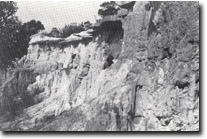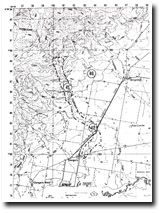40. Gravel Quarry - Toongabbie
|
This information has been developed from the publications:
|
| Location: | 634878. 3.5 kilometres west of Toongabbie. |  Ferruginous sandstone horizon (arrowed), developed in Haunted Hill Gravels - Toongabbie. |
Access: | Road from Traralgon – Maffra Road near Toongabbie. | |
Ownership: | Private Land. | |
Geology/Geomorphology: | A small quarry provides a clear exposure of Haunted Hill Gravels which here consist of variously coloured sands, minor gravels, and a prominent 30 cm thick bed of ferruginous sandstone. | |
Significance: | Regional. This is a very clear exposure of a sandy facies of the Haunted Gravels in the margins of the highlands and contrasts with the coarser gravel facies of the La Trobe Depression to the east. | |
Management: | Rapid gully development of abandoned quarry faces results in much of the exposure being obscured. Continued quarrying or occasional clearing of the section would be necessary to maintain the quality of the exposure. | |

Sites 8221-40 41 42


